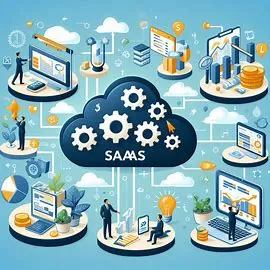Introduction
Welcome to the dynamic world of Software as a Service (SaaS), a paradigm reshaping how businesses leverage technology for growth and efficiency. In this comprehensive guide, we delve deep into the essence of SaaS, exploring its benefits, challenges, and the profound impact it holds for businesses aiming to stay competitive in a digitally-driven marketplace.
Definition of SaaS (Software as a Service)
SaaS stands for Software as a Service, a cloud-based service where, instead of downloading software to your local device to run and update, you access an application via an internet browser. The software application resides on external servers, where it is maintained and updated by the SaaS provider. This model allows users to access software applications on a subscription basis without complex hardware management, leading to cost reductions and enhanced scalability.
Overview of the benefits and drawbacks of SaaS for businesses
Visual Representation of SaaS Integration into Business Operations
SaaS offers numerous advantages such as cost-efficiency, scalability, easy upgrades, and accessibility. However, it also presents challenges like limited control over software customization and concerns about data security. Understanding these trade-offs is crucial for businesses to make informed decisions.
II. Advantages of SaaS
The adoption of SaaS brings transformative benefits to businesses, streamlining operations and fostering innovation. Let's explore these advantages in detail.
A. Reduced Time to Benefit
The SaaS model enables rapid deployment of applications, significantly reducing the time to benefit. Businesses can quickly enjoy the software's functionality, which is especially beneficial in fast-paced industries.
B. Lower Costs
SaaS can be more cost-effective compared to traditional software installation. It eliminates the upfront cost of purchase/installation and ongoing costs like maintenance and upgrades, thus reducing the total cost of ownership.
C. Scalability and Integration
SaaS provides high scalability, giving businesses the option to access more or fewer services or features depending on their needs. Additionally, most SaaS platforms integrate easily with other business systems, which is critical in today’s interconnected digital ecosystems.
D. New Releases (Upgrades)
With SaaS, the provider manages all updates and upgrades, eliminating the need for customers to handle software maintenance. This minimizes IT staff workloads and ensures businesses are always running on the latest software version with all the new features and bug fixes.
E. Ease of Use and Proof-of-Concepts
SaaS offerings are usually user-friendly, with streamlined interfaces and supportive vendor documentation. This ease of use facilitates quicker adoption amongst teams. Moreover, many SaaS providers offer a "try before you buy" feature through proofs of concept, reducing the financial risks associated with new software.
III. Benefits of SaaS Scalability
Scalability is one of the standout features of the SaaS model, empowering businesses to grow at their pace without being hindered by software limitations.
A. Flexible Payments
The scalability of SaaS is accompanied by flexible payment options. Businesses can opt for subscription models that scale up or down based on usage, which helps maintain cash flow flexibility.
B. Quick Scalability Without Additional Hardware or Software Investments
Scaling SaaS solutions does not require additional hardware or significant upfront software expenses, allowing businesses to expand their capabilities rapidly with minimal delays.
C. Access to More Features as Businesses Grow
As enterprises expand, they can access more advanced features and functionalities offered by SaaS platforms, facilitating enhanced business operations and better customer service.
IV. Considerations for Choosing SaaS
Selecting the right SaaS solution requires careful consideration of several factors to ensure alignment with business goals.
A. Subscription Plans for Rapid Deployment
Choosing the right subscription plan is essential for ensuring rapid deployment and operational efficiency. Plans should align with the business size, needs, and growth projections.
B. Impact of Internet Connection on SaaS Application Performance
SaaS Ecosystem Landscape
The dependency on a stable internet connection is critical for SaaS applications. Poor connectivity can lead to service disruptions and productivity losses. Thus, assessing network infrastructure should be a priority when considering SaaS.
C. Trade-Off Between Customization and Control
While SaaS offers many advantages, one of the trade-offs includes limited customization and control over the software. Companies need to evaluate whether the standard offerings align with their specific processes or if more tailored solutions are necessary.
V. Conclusion
In conclusion, SaaS presents a compelling proposition for businesses looking to enhance efficiency and agility. The benefits of reduced costs, scalability, and ease of use make it an attractive option for companies across various sectors. As we move into 2025 and beyond, businesses should explore how SaaS can be strategically implemented to support their growth.





0 Comments